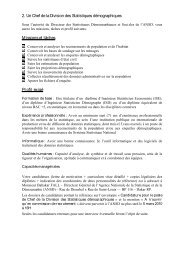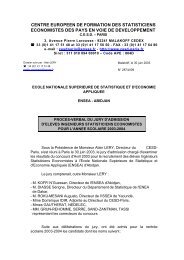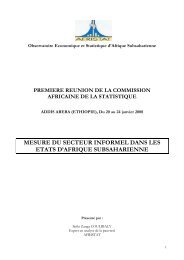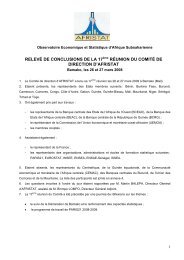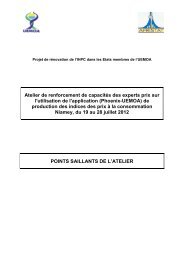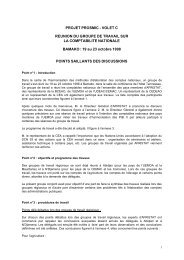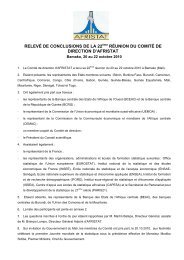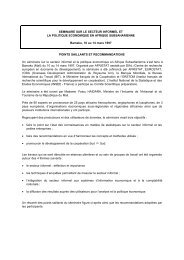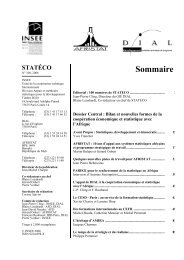Global Purchasing Power Parities and Real Expenditures - Afristat
Global Purchasing Power Parities and Real Expenditures - Afristat
Global Purchasing Power Parities and Real Expenditures - Afristat
Create successful ePaper yourself
Turn your PDF publications into a flip-book with our unique Google optimized e-Paper software.
148 <strong>Global</strong> <strong>Purchasing</strong> <strong>Power</strong> <strong>Parities</strong> <strong>and</strong> <strong>Real</strong> <strong>Expenditures</strong>rent. The first approach is the quantity method, in whichphysical measures of the numbers <strong>and</strong> characteristics ofdwellings are used to produce comparable real expenditureson housing. The second approach is the direct rentapproach, in which rental data for comparable housingtypes (apartment, house, <strong>and</strong> so forth) are used to computethe PPP for the dwelling basic heading. In the absence ofdetailed rental data <strong>and</strong> detailed information on the numbers<strong>and</strong> characteristics of dwellings, Asia-Pacific <strong>and</strong> Africaused the PPP for individual consumption expenditures byhouseholds (excluding rentals for housing) as a referencePPP for housing. This is a neutral approach in the sensethat housing has no effect on the overall PPP for individualconsumption. South America <strong>and</strong> CIS used the quantitymethod. Western Asia <strong>and</strong> Eurostat-OECD used a combinationof the first two methods.GovernmentFor ICP purposes, government final consumption expenditurewas divided into two components: expenditure bygeneral government on collective consumption goods <strong>and</strong>services <strong>and</strong> expenditure by general government on individualconsumption services. The collective consumptioncomponent covers services that are provided to the communityas a whole, such as defense, police, <strong>and</strong> firefighting.The individual component relates to those services providedto specific individuals, such as health <strong>and</strong> education.In the ICP, a national accounting aggregate known as“actual individual consumption expenditure” was used forcomparison of household consumption. It comprises householdfinal consumption expenditure plus the individualcomponent of government final consumption expenditure<strong>and</strong> the final consumption expenditure by nonprofit institutionsserving households (NPISHs). The reason for usingactual individual consumption expenditure is that it is notaffected by the extent to which services such as health<strong>and</strong> education are financed by government or purchaseddirectly by households.The national accounting convention for measuring nonmarketoutputs is the input-cost approach, which meansthat they are recorded as the sum of the wage costs of theemployees involved plus the intermediate consumption ofgoods <strong>and</strong> services (materials used, rents, <strong>and</strong> so forth) <strong>and</strong>consumption of fixed capital. Collective consumption bygovernment <strong>and</strong> nonmarket services in health <strong>and</strong> educationproduced by government include basic headings forcompensation of employees, intermediate consumption,<strong>and</strong> some other smaller items (as shown in appendix E).PPPs for compensation of employees were compiled bycomparing salaries between economies for a number ofcarefully selected <strong>and</strong> well-defined jobs that are typical ofgovernment expenditures around the world, for both theregional <strong>and</strong> ring comparisons.Measuring the compensation of government employeesis a difficult area for ICP because labor productivityin government varies widely between economies. For theEurostat-OECD, CIS, <strong>and</strong> South America regions, productivitydifferences were ignored because they were judgedto be so small that ignoring them would not affect regionalcomparisons. However, the participating economies in theAsia-Pacific, Africa, <strong>and</strong> Western Asia regions are at verydifferent levels of economic development, reflected in governmentcompensation levels. For example, in Asia-Pacific,average compensation (based on exchange rates) in thegovernment health sector of Hong Kong was about 120times higher than in the Lao People’s Democratic Republic(PDR). If no productivity adjustments were made, economiessuch as Vietnam, Cambodia, or Lao PDR, where governmentsalaries are very low, would be seen as having veryhigh real consumption of government services—<strong>and</strong> hencevery high real GDP—compared with economies such asHong Kong <strong>and</strong> Singapore, where government salaries arerelatively much higher.The solution adopted by these regions was to adjust governmentcompensation, <strong>and</strong> hence government consumptionexpenditure, for differences in productivity. (Details onthe productivity adjustment can be found in appendix D.)HealthFor ICP purposes, basic headings for expenditures onmedical products <strong>and</strong> health services were included underhousehold consumption <strong>and</strong> individual consumption bygovernment. Government expenditures included additionalbasic headings for the production of health services.This classification reflects the different ways that healthproducts <strong>and</strong> services can be purchased:m Households purchase them directly <strong>and</strong> pay forthem in full.



